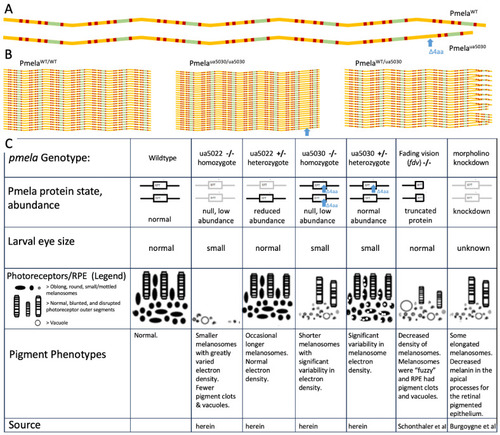
Summary of pmela genotype–phenotype relations and illustrations suggesting how the heterozygous ua5030 phenotype might be attributed to aberrant fibril formation and melanin deposition. (A) The linear wildtype (WT) peptide has a subset of residues colour-coded for their biochemical properties, akin to Figure 2. There are seven repeated modules. We assume a small conformational change (details unknown) at the location of the 4-residue deletion (Δ4aa, blue arrow), represented here by the absence of a slight bend in the peptide shape at the C-terminal repeat. (B) Homozygous mutant Pmela can stack together effectively (akin to WT), where the mutant is disrupted (e.g., 4 residues shorter) consistent with lost function (abundance of this protein is low in homozygous mutants). In heterozygous PmelaWT/ua5030 fish, the melanosome has a mixture of two different peptides that try to assemble, and the stacking is disrupted (apparent on right side of the stack). Top half of the heterozygous stack imagines a 1:1 ratio and exactly reiterated WT/mutant/WT/mutant peptides, and bottom of stack imagines a more random recruitment of WT vs. mutant peptides. This is meant to represent how the intermolecular interaction of PMEL variants might be impactful in the heterozygous state (disrupting melanin pigment deposition and melanosome shape), consistent with a dominant inheritance. Imagine each stack is extended top and bottom to make a fibril, and fibrils then form a scaffold for both melanin deposition and melanosome morphogenesis. This simplified schematic ignores various details of PMEL biochemistry. (C) Summary of how pigmentation phenotypes differ in various disruptions. Repeat domain (RPT) presented as a box, protein schematic summarizes the different phenotypes using gray colouration for hypomorphs or null mutations, and truncations in fdv are schematized shorter. The legend shows the various changes to the photoreceptors and retinal pigmented epithelium: see text and previously published works [1,19,20]. Near-absence of Pmela or loss-of-function mutation produces pigment phenotypes, but moderately reduced abundance of Pmela does not. Phenotypes in ua5030 heterozygotes are consistent with an altered RPT domain leading to dominant inheritance of pigmentation deficits.
|

